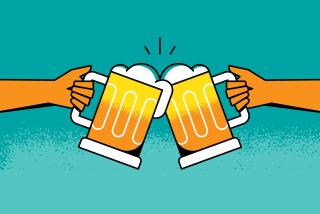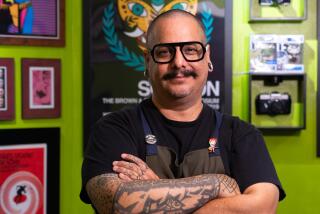Mexican culture in a sweaty headlock
Tlacolula, Mexico — JACK BLACK’S comic antics often leave audiences in stitches. Now Black himself is being sewn back together, a jagged line of dark thread embroidered around his eye.
His impromptu surgery was necessitated by a stunt sequence in his latest cinematic venture, “Nacho Libre.” That’s what comes from being a successful Hollywood leading man with a bent for throwing yourself headfirst into the action, literally.
“I’m delicate, like a piece of china,” says Black, whose barrel-chested bulk is more suggestive of the Great Wall than a Ming vase. “I dived ... and fell on some people and I hit a chair. Busted my eye. It was fun: I got a nice little three-day vacation. Scarred for life -- the scar’s not going to go away. But that’s part of the job.”
Funny guy, this Black, and, in his own unique way, surprisingly agile and athletic -- which you already knew if you saw him crank up those righteous guitar solos in “High Fidelity” and “School of Rock.” These may be just the qualities he’ll need to carry off the stout title role in “Nacho Libre,” a bruising comedy that director Jared Hess (“Napoleon Dynamite”) and a Mexican American crew spent filming here last fall. The Paramount Pictures release, which is being produced by Nickelodeon Movies along with Black’s production company, Black and White Productions, is slated to reach theaters this summer.
Fresh off his appearance as a smarmy action-film director in Peter Jackson’s “King Kong” remake, Black stars in “Nacho Libre” as another kind of high-spirited scrapper risking life and limb to pursue his obsessively offbeat dreams. He’s Ignacio (a.k.a. “Nacho”), a Norwegian Mexican kitchen worker and priest-in-training at a Mexican orphanage, with a heart of pure gold and a midsection of pure cellulite.
Various complications naturally ensue, and when the orphanage is threatened with closure, Nacho dons a mask and moonlights as a luchador, a practitioner of the anything-goes style of Mexican professional wrestling known as lucha libre (“free fighting”). Black describes his character as “a little bit vain, but he’s also a little sweet and innocent.”
Lucha libre is a longtime fixture of Mexican pop culture that reached its commercial and creative zenith between the 1940s and early 1980s. That’s when star wrestling personalities such as Santo and Blue Demon ruled the ring and a slew of Cine Luchador flicks transformed a marginal “sport” into a full-blown subculture. (“Nacho Libre” takes place in lucha‘s 1970s heyday.) Several of these flicks were camp masterpieces, and their melodramatic plots frequently involved a more or less heartfelt element of personal struggle as the heroic luchador battled evil adversaries and fickle fate.
And although “Nacho Libre’s” lead role is being played by a non-Latino who estimates his Spanish vocabulary at 40 words, the filmmakers say their movie takes a respectfully knowledgeable, if humorous, view of Mexican popular culture. “We didn’t want to be a gringo-Hollywood production,” says co-producer Julia Pistor.
Even granted lucha libre‘s innate absurdity, the goofy premise of “Nacho Libre” may seem like something cooked up after one too many mescals. Not so. It’s loosely inspired by a real-life Mexican priest who, for more than 20 years, lived a double life as a luchador nicknamed Fray Tormenta (Friar Storm), taking part in some 4,000 bouts. Some of the money he earned went to fund an orphanage that he ran.
Though the “Nacho Libre” team met with Fray Tormenta, who still lives near Mexico City, the idea wasn’t to make “a straight-ahead biopic,” says Mike White, the movie’s co-screenwriter and Black’s production partner. “It’s funny,” White says. “We’re doing a movie about something that’s very inauthentic, but it’s so authentic in Mexican culture.”
Though lucha libre‘s conventions -- elaborate body-slamming maneuvers, flashy capes and masks, midget wrestlers -- are less well known on this side of the border, lucha libre has gradually developed a fervid U.S. following. Black is now among the devotees. “I knew the Mexican wrestlers,” he says, pausing between scenes under the withering Oaxacan sun, while an assistant teases his long, shaggy hair into fighting trim. “I thought they looked cool, but I’d never been to a match. There’s a lot of impressive moves. But also the theatricality is so fun to watch.”
The only thing in the movie more theatrical than the lucha libre throwdowns may be the dramatic Mexican backdrops. Much of “Nacho Libre” is being shot in this majestically beautiful corner of southern Mexico, about a six-hour drive from Mexico City. Prized for its rich indigenous culture, the state of Oaxaca also is one of Mexico’s great culinary meccas. “It’s been a struggle to keep a fighting weight,” says Black, polishing off an elote -- corn on the cob slathered in mayonnaise. “Much of the movie I’m shirtless. Fat is funny.”
Unlike many Hollywood films set in Mexico, “Nacho Libre” aspires to a truly bicultural sensibility. Most of its principal and secondary roles were cast with Mexican or Mexican American talent: Ana de la Reguera as an angelic young nun, Sister Encarnacion, who teaches at the orphanage; Hector Jimenez as Nacho’s wrestling partner and faithful sidekick Esqueleto (the Skeleton); Carla Jimenez as a spoiled rich girl with an unrequited crush on Esqueleto; Richard Montoya of the Los Angeles-based theatrical comedy ensemble Culture Clash as Nacho’s chief rival for the beautiful Sister Encarnacion’s friendship and romantic favors; and the “Galindo brothers,” a wrestling tag-team of Oaxacan pseudo-siblings.
“It’s not just a Jack Black movie where he’s the engine driving the comedy,” says White, who worked on the screenplay with Hess and the director’s wife and collaborator, Jerusha Hess. “Jack is a really funny element among many elements. This is a world you would want to get inside and experience with or without Jack as a protagonist.”
White compares the movie’s depiction of provincial Mexico, with its picturesque pueblitos and cactus-studded vistas, to the affectionately tongue-in-cheek way that small-town Idaho appeared in “Napoleon Dynamite.” “We don’t want to do ‘Three Amigos,’ where the source of comedy comes from stereotypes or movies you’ve seen before,” White says.
Black may not be the movie’s sole raison d’etre. But no one visiting the set last fall could miss his fireplug presence, striding around bare-chested in red-and-blue wrestler’s tights, white boots and a matinee-idol’s pencil mustache. To prepare for the role, Black says, he trained with a wrestler in Los Angeles who “taught me some kick-ass moves” and how “to use the ropes for maximum velocity.”
Asked to name his favorite technique, Black narrows his eyes and a wicked smile slithers across his face. “I’m going to go with the python squeeze. Woe to he who doubts the fury of the dreaded python squeeze!” But Black allows that he leaves some of the heavier lifting in the film -- diving off cliffs, being engulfed in flames -- to his stunt doubles, one of whom broke three ribs during filming.
*
Facing fears ... of grasshoppers
AS Black prepares for another scene in which a disconsolate Nacho has gone into the desert to search his soul, he’s girding his loins to try one of Oaxaca’s signature foods: chapulines, or grasshoppers. “This whole movie for me has been about facing my fears,” he says. “Today I am going to face one of my biggest fears: eating grasshoppers.”
White, Pistor and other crew members who’ve taken shelter from the sun under a white plastic tent chuckle at Black’s repartee. On a hillside some hundred yards away, clumps of people from the nearby village have gathered to watch the proceedings. No one from the film crew or security staff seems to mind, a reflection of the high-spirited but low-stress atmosphere that the crew attributes to Black and Hess’ genial influence.
A gangly, stork-like figure in shorts and plaid shirt, Hess scampers across the rocky hillside where the day’s sequences are being shot, sidestepping cactuses and burro droppings. Visible on a peak directly across the sun-streaked valley are the bleached ruins of the ancient Indian site of Yagul. “It’s just so quaint, and I feel like it’s such a beautiful part of Mexico,” says Hess, who learned to speak fluent Spanish while serving in Venezuela as a Mormon missionary a few years ago.
Hess has become enthralled with “the whole aesthetic and the vibe” of lucha libre. But while the sport is wrapped in mythic personalities and heroic clashes between tecnicos (good guys) and rudos (bad guys), luchadores don’t possess superhuman qualities, Hess points out. Instead, their appeal derives from their flesh-and-blood triumphs and defeats, and it’s this all-too-human quality that helps Nacho’s character come alive on the screen, Hess believes. “I find it unrealistic when characters in a film just have one objective that you’re going for,” Hess says. “Nacho has a lot of characteristics. He does have a lot of very Don Quixote-like adventures.”
Hess politely excuses himself and dashes off to talk with his crew. The sun is beginning to slip behind the mountains, and there’s still some more filming to be done. “You got the scoop?” Black asks a reporter. “Not till you see me eat the grasshopper, you don’t.”
After filming wraps up for good, Black says, he’s going to need a vacation to “heal up some bangs and bruises.” As for “Nacho Libre,” besides the movie there’s already a video game in the works. Will there be action figurines too, or perhaps lucha versions of the old Rock ‘Em Sock ‘Em Robots?
“There’d better be a Galindo action figure,” Hess says, speaking of the wrestling team. “Those guys blew my mind.”
More to Read
Only good movies
Get the Indie Focus newsletter, Mark Olsen's weekly guide to the world of cinema.
You may occasionally receive promotional content from the Los Angeles Times.









